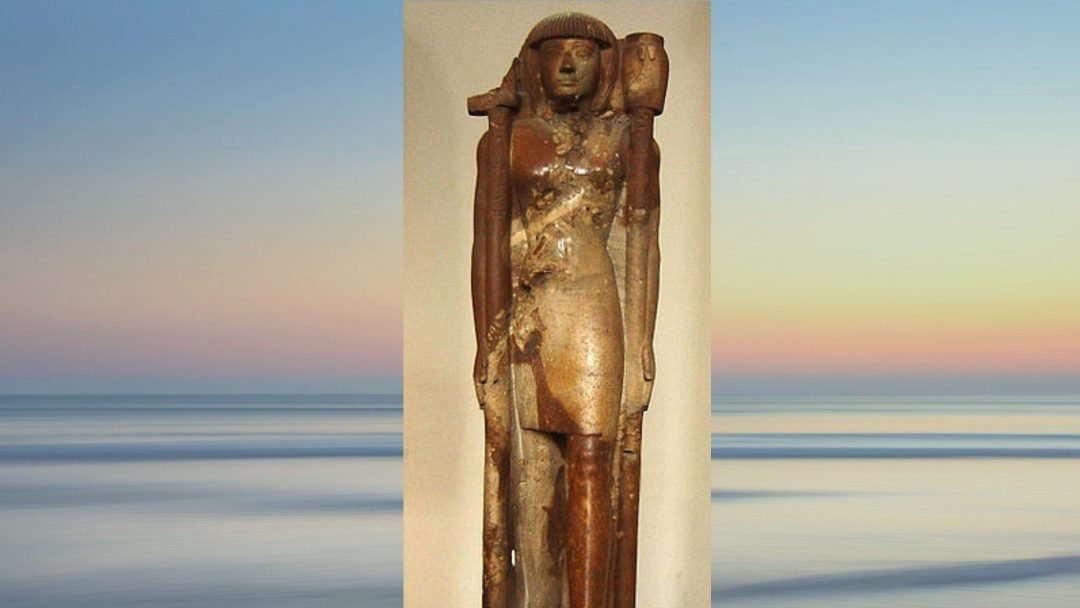Khamuas High Priest & Master of the Temple

The Seer was immediately transported to the Great Pyramid and the Nile. In a vast Temple a man dressed in fine white linen with gold brocaid appeared. He confirmed he was Khamuas, and that the prime function of the Servitors was to maintain a direct lineage of knowledge and power down the ages from Atlantis through Egypt, Europe, the present day, and beyond. As keeper of the scrolls, and Priest of Thoth, Khamuas personifies spiritual knowledge and power.
Khamuas, son of Ramses II and Isis-nefert, lived around 1250 BCE. He
was the guiding spirit behind the Sphere Group of Florence Farr, and later the circle of magicians around Dion Fortune.
Temple of Khamuas
Gerald Massey in Ancient Egypt – the Light of the World, says of Khamuas:
Seven stars in a group were witnesses to the power that was permanent at the pole, the power of stability, of equilibrium, and of the scales of justice which they served as “the seven arms of the balance” on
the day of judgment. But there are “two witnesses” particularly specialised in Revelation. These are said to be “the two olive-trees and the two lampstands standing before the Lord of the earth” (Ch. xi. 4). These two witnesses are to be met with in the Egyptian judgment scenes. In the second tale of Khamuas, a scene of the Osirian judgment is portrayed. The seven halls or mansions of Osiris and the lords of eternity
are here described as the seven “arits” or watch-towers, the same as in the Ritual (ch. 144). The seven are represented as a series, the seventh being the last. It is said that, “They entered the seventh Hall, and behold! Setme saw the figure of Osiris the great god seated upon his throne of fine gold, and crowned with his atef-crown”; “Anup the great god being on his left, and the great god Taht on his right, with the gods of the council standing in their places: standing and making proclamation”.The Balance was set in the midst before them, and they were weighing the evil deeds against the good deeds, the great god Taht (Aan) recording, with Anup giving the word to his colleague (Griffith, Second Tale of Khamuas, pp. 46, 48). These are the prototypal “two witnesses” stellar and lunar for the Father and son in the solar mythos. Taht-Aan was the witness for Horus, the only-begotten son of the father. In the mythos, which preceded the eschatology, Taht-Aan was the light of the world as the god whose luminary was the moon. Read doctrinally, he was not the true light, but he came that he [Page 706] might bear witness to the true light.
The lunar god was one of the powers in nature that was born of the motherhood; whereas Horus, of the resurrection, was begotten by the father, and Tat bore witness that Horus, not Aan, was the true light of the world, and the one direct representative of the father-god, who was Ra the holy spirit in the eschatology. Horus (or Iu) is the Word that was with God the Father in the beginning. He is the only Son who issued from the Father; the Son who converses with the Father; the Son who was instructed of the Father to reflect and reveal the nature of the God in Spirit as the One Eternal Power. Anup may be traced in Amenta as the witness for Horus the child, who was the Word; Aan is the witness for Horus the adult who is the word made truth. Hence, he is the giver of the talismanic makheru; also the divine scribe who avouches the truth of the Word in the writings. These, as Egyptian, are the “two witnesses” who were present in the hall of judgment.
With the rapid unfolding of the spiritual powers, the foundation is set for the creation of Temples dedicated to the discovery, study and use of ancient spiritual knowledge in rituals and magick.
There are several versions of Khamuas’ name: Kha’emuast, Setna Khamuas,
Setne Khamuast.

